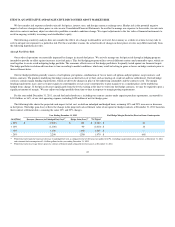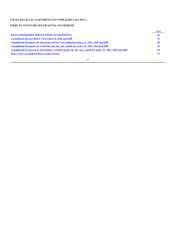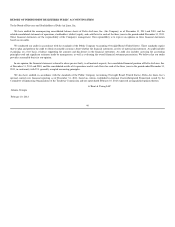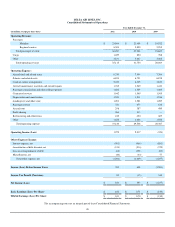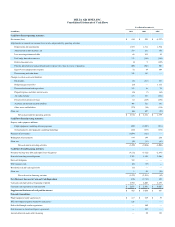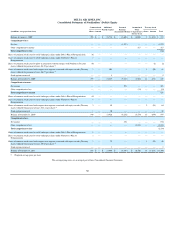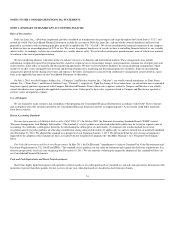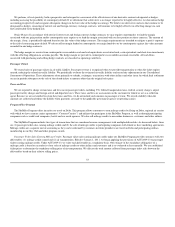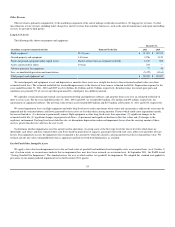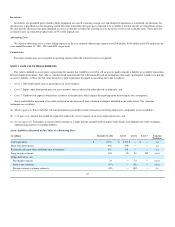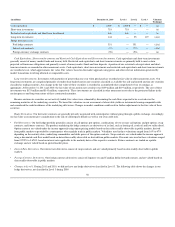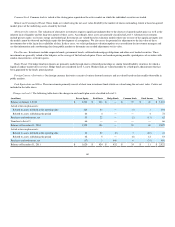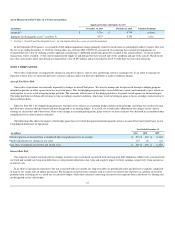Delta Airlines 2011 Annual Report Download - page 59
Download and view the complete annual report
Please find page 59 of the 2011 Delta Airlines annual report below. You can navigate through the pages in the report by either clicking on the pages listed below, or by using the keyword search tool below to find specific information within the annual report.
NOTES TO THE CONSOLIDATED FINANCIAL STATEMENTS
NOTE 1. SUMMARY OF SIGNIFICANT ACCOUNTING POLICIES
Basis of Presentation
Delta Air Lines, Inc., a Delaware corporation, provides scheduled air transportation for passengers and cargo throughout the United States (“U.S.”) and
around the world. Our Consolidated Financial Statements include the accounts of Delta Air Lines, Inc. and our wholly-owned subsidiaries and have been
prepared in accordance with accounting principles generally accepted in the U.S. (“GAAP”). We do not consolidate the financial statements of any company
in which we have an ownership interest of 50% or less. We are not the primary beneficiary of, nor do we have a controlling financial interest in, any variable
interest entity. Accordingly, we have not consolidated any variable interest entity. We reclassified certain prior period amounts, none of which were material,
to conform to the current period presentation.
We have marketing alliances with other airlines to enhance our access to domestic and international markets. These arrangements may include
codesharing, reciprocal frequent flyer program benefits, shared or reciprocal access to passenger lounges, joint promotions, common use of airport gates and
ticket counters, ticket office co-location and other marketing agreements. We have received antitrust immunity for certain marketing arrangements, which
enables us to offer a more integrated route network and develop common sales, marketing and discount programs for customers. Some of our marketing
arrangements provide for the sharing of revenues and expenses. Revenues and expenses associated with collaborative arrangements are presented on a gross
basis in the applicable line items on our Consolidated Statements of Operations.
On July 1, 2010, we sold Compass Airlines, Inc. (“Compass”) and Mesaba Aviation, Inc. (“Mesaba”), our wholly-owned subsidiaries, to Trans States
Airlines, Inc. (“Trans States”) and Pinnacle Airlines Corp. (“Pinnacle”), respectively. Upon the closing of these transactions, we entered into new or amended
long-term capacity purchase agreements with Compass, Mesaba and Pinnacle. Prior to these sales, expenses related to Compass and Mesaba as our wholly-
owned subsidiaries were reported in the applicable expense line items. Subsequent to these sales, expenses related to Compass and Mesaba are reported as
contract carrier arrangements expense.
Use of Estimates
We are required to make estimates and assumptions when preparing our Consolidated Financial Statements in accordance with GAAP. These estimates
and assumptions affect the amounts reported in our Consolidated Financial Statements and the accompanying notes. Actual results could differ materially
from those estimates.
Recent Accounting Standards
Revenue Arrangements with Multiple Deliverables ("ASU 2009-13"). In October 2009, the Financial Accounting Standards Board ("FASB") issued
"Revenue Arrangements with Multiple Deliverables." The standard (1) revises guidance on when individual deliverables may be treated as separate units of
accounting, (2) establishes a selling price hierarchy for determining the selling price of a deliverable, (3) eliminates the residual method for revenue
recognition and (4) provides guidance on allocating consideration among separate deliverables. It applies only to contracts entered into or materially modified
after December 31, 2010. We adopted this standard on a prospective basis beginning January 1, 2011. We determined that the only revenue arrangements
impacted by the adoption of this standard are those associated with our frequent flyer program (the "SkyMiles Program"). See "Frequent Flyer Program"
below.
Fair Value Measurement and Disclosure Requirements. In May 2011, the FASB issued "Amendments to Achieve Common Fair Value Measurement and
Disclosure Requirements in U.S. GAAP and IFRSs." The standard revises guidance for fair value measurement and expands the disclosure requirements. It is
effective prospectively for fiscal years beginning after December 15, 2011. We are currently evaluating the impact the adoption of this standard will have on
our Consolidated Financial Statements.
Cash and Cash Equivalents and Short-Term Investments
Short-term, highly liquid investments with maturities of three months or less when purchased are classified as cash and cash equivalents. Investments with
maturities of greater than three months, but not in excess of one year, when purchased are classified as short-term investments.
51


